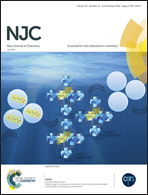Synthesis of poly(α-olefins) containing rare short-chain branches by dinuclear Ni-based catalysts†
Abstract
1-Hexene homopolymer samples produced by a series of mononuclear (MCn, n = 1–3) and rigid/flexible bridged dinuclear (BCn, n = 1–7) Ni-based catalysts were characterized by 13C NMR, DSC, and GPC-IR analyses. Mononuclear catalysts through normal insertion produced poly(1-hexene) with a high amount of butyl branches, while dinuclear catalysts were able to polymerize 1-hexene with a high level of rare branches (ethyl and propyl) due to the partial chain walking mechanism. Theoretical calculation was employed in order to study the dinuclear catalysts, which confirmed the presence of two stereoisomers via the broadening of MWD, a different mechanism of polymerization and short chain branch (SCB) curves. The effects of the cocatalyst type (DEAC, EASC and MMAO) and concentration, time and temperature along with the polymerization of higher α-olefins (1-octene and 1-decene) on the behavior of dinuclear catalyst BC2 and polymer properties were investigated. As a result, in addition to catalyst structure, the monomer length and polymerization temperature were the two factors controlling the stability of the stereoisomers due to agostic interaction and kinetic energy, respectively.



 Please wait while we load your content...
Please wait while we load your content...